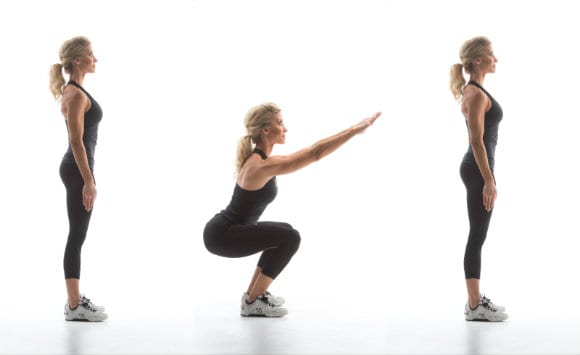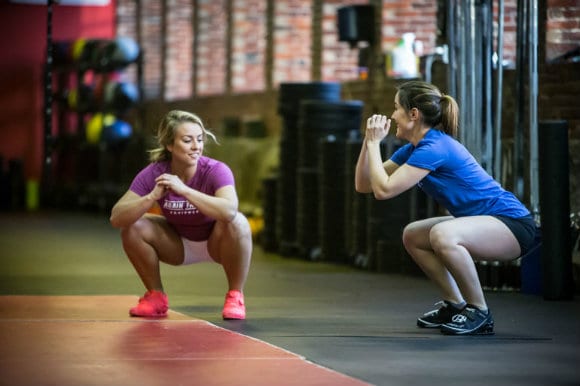By the healthiergang writer , personal trainer.
Air Squat
Air squat, also called bodyweight squat, is an effective exercise for both newbies and advanced athletes.
This exercise mainly affects the muscles of the lower limbs, especially the small and large buttocks and the thigh muscles (hip-knee segment) or the quadriceps and hamstrings.
variants
Like the back squat, it has an infinite number of variations on the basis of which different muscle groups can be involved more, for example:
? the more we spread our legs, the more adductors and hamstrings will come into play;
? with the lower limbs close we will have a greater call on the quadriceps;
? increasing the depth of the movement (squatting complete) will lengthen the buttock, which, in ascent, will allow a greater contraction;
? by interrupting the movement reached the parallel we will have less involvement of the gluteus and a greater involvement of the quadriceps.
execution
A big advantage of this exercise is that it can be done virtually anywhere without the need for equipment, moreover, given its simplicity of execution (for the nervous system, not because it is technically easy to do it correctly) it can be performed as a preparation for the back or front squat or to strengthen the lower limbs after a long period of stop even after injury (ask in the latter case the doctor's opinion).
Starting position for the classic air squat:
1) feet shoulder width apart or slightly more;
2) toes parallel and directed forward;
3) keep the lumbar curvature and the back straight as much as possible;
4) adducted shoulder blades;
5) arms extended forward;
6) line connecting eye and ear (frankfurt plane) parallel to the ground;
7) gaze straight ahead.

Performing from a standing position after getting ready:
1) flex hip and knee while lowering
2) continue to descend smoothly until you feel that the pelvis '' turns ''.
3) the knees during the descent phase follow the line of the foot.
4) the ankle joint (tibio tarsica) is also flexed dorsally to allow a slight advancement of the knees.
5) pushing with your feet (this is just to allow you to understand the sensation you have to feel when you get back up)
6) smoothly extend all joints that flexed at the beginning and ended with the hip;
7) inhale during the descent and exhale during the ascents
Throughout the movement, the arms are always stretched forward (relax) parallel to the ground and the gaze, as well as the head must be fixed.
Particular attention should be paid to the back, maintaining its physiological curvatures is FUNDAMENTAL, the technique for this type of exercise is the most important thing, even at the cost of sacrificing a couple of repetitions.
Common mistakes
The most common errors are generally referred to the position of the back, excessively inclined forward both in the ascent and descent phase, and to the too much retroversion of the pelvis by going down too squat compared to one's real possibilities.
You can play a training for the lower limbs complete only through the air squat and its variants, let's see an example:
If you have a deficiency in your buttocks or are looking for a greater development, which women often want, you could develop the training in the following way.
? From complete squats perform small dips (springs) to better activate the buttock 3 × 20
? Regular air squat maximum squat 4 × 20
? Air squat sumo, tips of the feet rotated towards 40-50 ° 3 × 20
? Air squat 1/2, to call up the quadriceps, 3 × 20
If, on the other hand, the lack is in the quadriceps, the training can be started with the air squat with feet close together or with a half air squat.
The number of repetitions I have entered is high because in general, being without added load these exercises do little stress on the body, but for those who have never tried it is more suitable to proceed step by step without overdoing it.

Practical Ideas
A progression to be able to do it in the best way can be this:
? Box air squat, starting from sitting trying to concentrate on pushing the legs and avoiding inappropriate movements of the back;
? Air squat ½, a slightly more evolved version of the previous exercise that allows you to focus the effort on the quadriceps in such a way as to be able to subsequently facilitate the rising movement from a complete squat;
? Air squat in complete squats;
? Air squat in full squat with arms extended upward (helps maintain correct back position).
For those who have difficulty descending in complete squats, I suggest performing mobility exercises for both the hips and the ankles.
For example, for the hips it can be a good exercise even very simple starting from sitting on a bench (from the long side) to raise a lower limb and keeping it flexed at the knee bring it to the other side (opening us, so to speak) and hold the position for 5 '', then return to the previous position and repeat either with the other limb or again with the same one.
For the more advanced, on the other hand, my advice is, starting from the maximum squatting position (coretta), keeping the upper limbs extended upwards, to maintain the 30 '' position, making an effort to go down a little more each time.
For the ankles, instead, simple circles or calf stretching exercises can be very helpful.
The last thing to consider is the progression when you reach a level that is able to correctly perform the movement in all its ROM.
To increase the difficulty / intensity of the training you can work mainly on the number of repetitions and series, on TUT (time under tension) emphasizing the eccentric phase as well as inserting stops in different phases of the movement (even in stretch situations as in acosciata).


























